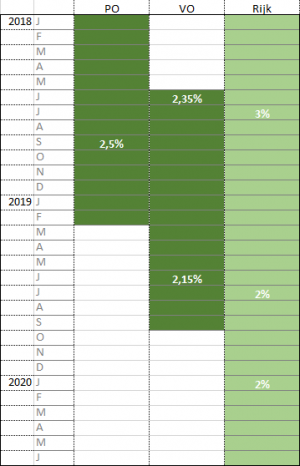Compare collective labor agreements? Pay attention to the duration
The wage increases are flying around your ears with all the collective labor agreements that are concluded these months, but basic percentages cannot simply be compared. To begin with: the chords all differ in duration.

Picture: Type tank
Civil servants receive no less than seven percent, headed many messages yesterday. A great result. Isn't that much more than that 4,5 percent for the staff in secondary schools, some wondered. In short: that is comparing apples to pears. The collective labor agreement for civil servants covers a period from January 2018 to June 2020, and has a term of 30 months. That is almost twice as long as the collective labor agreement for secondary education, which runs from June 2018 to October next year. For the period after that, the AOb and other unions are, of course, negotiating new wage increases.
Running times

Structural salary increase and terms of collective labor agreements
De collective labor agreement in primary and special education runs even shorter, until March 2019. There is also a reason for this. The actions in primary education will be continued after the summer holidays with a fifth regional strike, this time in South Holland and Zeeland. All this to persuade political The Hague with the necessary at Prinsjesdag 600 million to get over the bridge. The stakes are clear: a new collective labor agreement that further bridges the salary gap with secondary education.
Of course the structural wage increase is an important part of any negotiation agreement. But a collective labor agreement consists of more than these percentages. In primary education, for example, the wage scales are undergoing a major overhaul and the lowest LA salary scale is being eliminated. Many teachers notice this immediately in their wallet. This improvement comes on top of the structural wage increase of 2,5 percent.
One-time extras
In addition, there are the one-off extras, which also differ per collective agreement. For primary education, this is a gross amount of 750 euros, a fixed amount, while secondary education can look forward to a one-off payment of one percent. Finally, but no less important, agreements are made in the collective labor agreements to combat work pressure. In secondary education, for example, this means a reduction of one teaching hour per week.
For higher professional education, an agreement was already reached in March on a structural salary increase of 4,9 percent. The definitive collective labor agreement has been in effect since the beginning of this month available. All information can be found on the CLA page for this sector.


